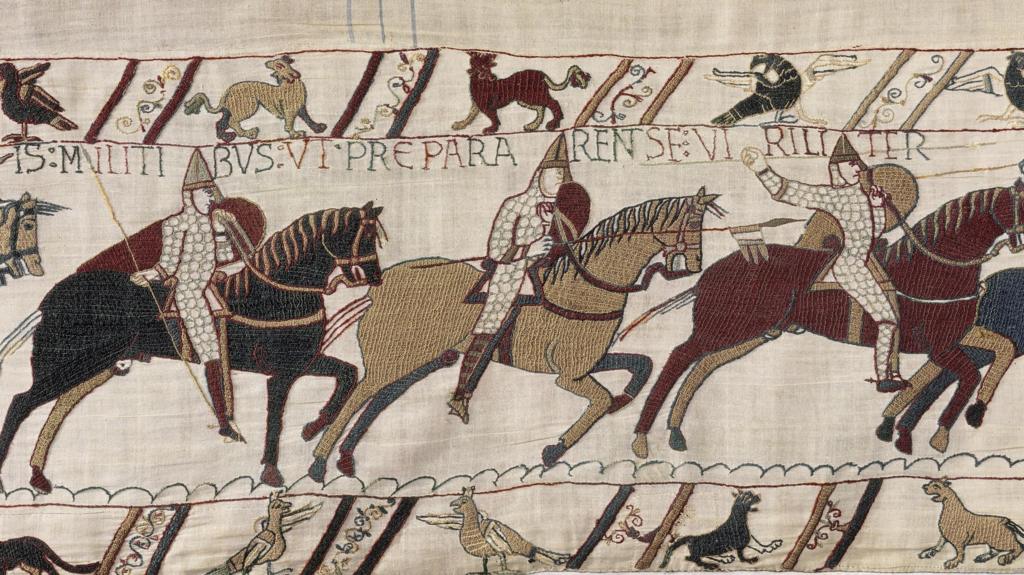The Bayeux Tapestry is set to return to the United Kingdom more than nine centuries after its creation, as confirmed by the Department for Culture, Media and Sport (DCMS).
This monumental 70-meter-long artwork, which vividly narrates the Norman conquest of England in 1066, will be loaned through a landmark agreement between the French and British governments.
The intricate embroidery – widely believed to have originated in Kent – is slated for display at the British Museum in London starting next year.
In a reciprocal gesture, significant cultural treasures, including artifacts from the Anglo-Saxon burial mounds at Sutton Hoo and the 12th-century Lewis chess pieces, will travel to museums in Normandy.
The Bayeux Tapestry will be on exhibit from Autumn 2026 until July 2027, coinciding with renovations at its current home, the Bayeux Museum, and the upcoming millennium anniversary of William the Conqueror’s birth in 2027.
George Osborne, Chair of the British Museum’s trustees, remarked to the BBC that the exhibition “will be the blockbuster show of our generation,” comparable to past sensations like Tutankhamun and the Terracotta Warriors.
Prime Minister Keir Starmer and French President Emmanuel Macron are anticipated to formally announce the accord Tuesday evening at Windsor Castle.
Culture Secretary Lisa Nandy described the loan as “a symbol of our shared history with our friends in France, a relationship built over centuries and one that continues to endure.”
The Bayeux Tapestry will be displayed from September 2026 until July 2027, while its current home, the Bayeux Museum, is being renovated. The 1000th anniversary of the birth of William the Conqueror is also in 2027.
Initial discussions regarding the loan began in 2018 between President Macron and then-Prime Minister Theresa May, culminating in its realization in 2025.
Dating back to the 11th century, the Bayeux Tapestry chronicles a pivotal era in Anglo-French relations, marked by the transition from Anglo-Saxon to Norman dominance.
Although the tapestry’s concluding section is missing, it concludes with the Anglo-Saxons fleeing at the conclusion of the Battle of Hastings in 1066.
Comprising 58 scenes, 626 figures, and 202 horses, it offers an unparalleled depiction of the medieval period in Normandy and England, providing insights into military traditions and intricate details of daily life.
The artwork has inspired numerous figures throughout history, including artist David Hockney, whose Frieze depicting the seasons in Normandy drew influence from the Bayeux Tapestry.
British Museum Director Nicholas Cullinan stated: “This is precisely the type of international collaboration that I aspire for us to champion and participate in: sharing the finest aspects of our collection as extensively as possible – and, in return, exhibiting global treasures never before witnessed here.”
Keen observers of the British Museum may interpret this latest announcement as a potential model for ongoing discussions with the Greek government concerning the future of the Parthenon Sculptures.
The Parthenon Project, an advocacy group for the return of the classical marble sculptures to Greece, has proposed a “win-win” solution involving the exchange of never-before-seen Greek artifacts for the Parthenon works at the British Museum.
For now, the focus remains on this upcoming exhibition, which the British Museum anticipates will be among its most popular ever, representing a once-in-a-generation opportunity.
Every British schoolchild learns about King Harold, William the Conqueror, and the year 1066.
As Osborne put it: “There is no other single item in British history that is so familiar, so studied in schools, so copied in art as the Bayeux Tapestry.
“Yet in almost 1,000 years it has never returned to these shores.
“Next year it will and many, many thousands of visitors, especially schoolchildren, will see it with their own eyes.”
A new exhibition at the British Museum in London traces the stunning evolution of India’s devotional art through 189 objects.
A complete set of 12 prints called Tokyo Story by Emily Allchurch has been acquired by the museum.
The Keighley Cliffe Castle display will contain objects from the British Museum, the council says.
Other top 10 attractions last year included Windsor Great Park and the National Museum of Scotland.
The London Museum of Water and Steam is given £2.6m while the Foundling Museum will get £320,000.

